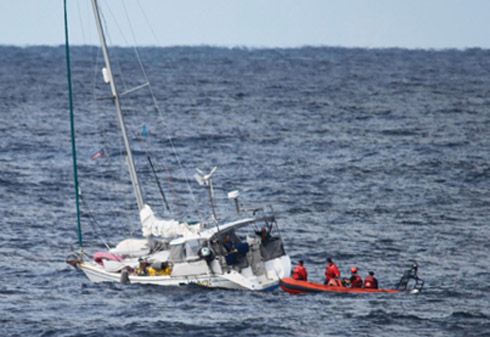(U.S. Coast Guard photo by Petty Officer 2nd Class Chris Harper)

Every November, I hold my breath as cruising sailors gird for the push southward from New England or mid-Atlantic to the Caribbean in one of the annual rallies organized for cruising sailors. Many of the people who participate in these rallies are new sailors, with limited offshore experience under their belt. The rally concept appeals to cruisers for many reasons, but underlying all of these is the belief that there is safety in numbers.
Last year, about this time, I shared my thoughts on rallies here. That blog post was prompted by the tragic loss of Jan Anderson, who was sailing with her husband, Rob, aboard a 38-foot Island Packet,Triple Stars. Triple Stars was one of 22 boats participating in the North Atlantic Rally for Cruisers.
The previous year, 46-year-old Laura Zekoll died while participating in the Carribean 1500, another Chesapeake Bay-to-Caribbean sailing event. This rally is now part of a worldwide series managed by the World Cruising Club, the company formed by cruising personality Jimmy Cornell, who is no longer involved in the events.
I was saddened, but not surprised, to learn that last week, participants in the Salty Dawg Rally, a free event that started in 2010 and which drew more than a 100 registered boats this year, ran into trouble. According to the Salty Dawg update posted Nov. 8 on the groups website, bad weather came faster than expected. Boats participating the Caribbean 1500, which departed earlier, managed to escape the brunt of the storm.
I wont go into the pros and cons of the rally concept again here, except to say that the timing of the departure is a key part of enjoying a fast, safe passage. While rally organizers will tout the benefits of having their expert advisors help determine optimal times for departure, there is no one-size-fits-all routing plan. Whats good for a fleet of lightweight, long, lean fin-keelers isn’t necessarily good for the owner of a stubby, heavy-displacement, full-keel cruising ketch, and vice versa.
What is interesting to me is that the rally with the less regimented schedule is the one that ran into trouble. It seems that even participants in events with no fixed departure date are just as likely to run into trouble as events with a firm date of departure.
Apart from the approach to departure timing, the two events differ in other ways as well. The Salty Dawg Rally participants depart from multiple ports in the general area near Beaufort, N.C., and Hampton, Va., while the Caribbean 1500 leaves en masse from Portsmouth, Va. The Salty Dawg has no minimum gear requirements; the Caribbean 1500 sets some minimum safety standards based the International Sailing Federation (ISAF) Offshore Special Regulations. But standards are just a starting point, and as weve seen before, even a well-equipped boat can run into trouble if the crew isn’t up to the task.
While the Salty Dawg Rally website states that its official basic . . . philosophy is to have each skipper determine the schedule of their own vessel . . ., it added that many skippers heeding the advice of weather-router Chris Parker, decided to start on Wednesday [Nov.] 6 while others delayed their departures until [Nov.] 7 and 8. The Caribbean 1500, based on information from routing service Weather Routing Inc., actually departed one day earlier than scheduled, on Nov. 2.
As the storm battered the fleet in the Salty Dawg rally, distress calls went out from several boats, and the U.S. Coast Guard, with the assistance of the Navy, responded to emergencies on five boats. No sailors were lost, but one boat was dismasted, the Catalina 42 Jammin lost its rudder, and one crew member broke his arm. Four crew members from the 41-foot sailboat Ahimsa had to be airlifted to safety.
Hindsight is always 20-20, and I have no doubt that there are rally participants who attribute their safe and uneventful passages to the support that the rally-framework provided. However, last weeks episode offers more evidence that the security of sailing in a big group may be more a matter of perception, than reality.

































